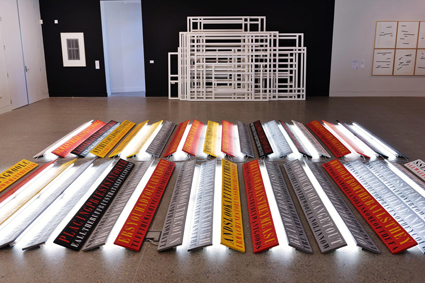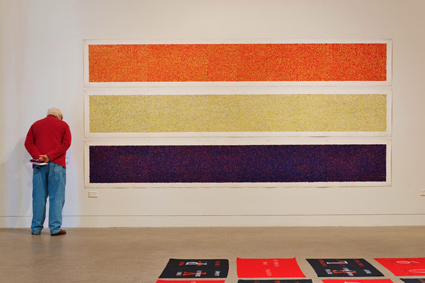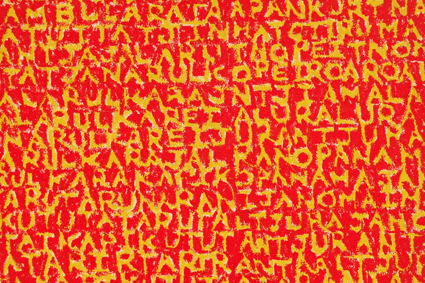 |
Ruark Lewis and Jonathan Jones, Homeland Illuminations, 1997 photo Alex Wisser |
Frequently with long gestating periods, these concerns have deepened in complexity over time. How then to steer the viewer through such a labyrinthine practice in ways that are legible, accessible and engaging?
In an interview I conducted with Lewis prior to the launch of the first installment of his two-part survey beginning at Hazelhurst Regional Gallery in late September (see RT111), it was clear that the artist had given much thought to such a question. He explained his intention to create a certain formality within the main gallery space while activating the outdoor areas in a more informal fashion to encourage visitor interactivity and hands-on engagement. Walking through the installed exhibition a month later, expertly curated by Dr James Paull, I sensed immediately that this approach had paid off. As I paced the open and airy expanse of the Federation Room gallery, there was a sense of elegant restraint in its pared-back organisation, which encouraged visitors to move slowly through its delicately choreographed space and to trace links and discover correspondences between works.
At the eastern end of the gallery, the focal point was the alluring juxtaposition of light and language in Homeland Illuminations (2007). A collaboration between Lewis and urban Indigenous artist Jonathan Jones (with whom Lewis has worked on a number of projects), the floor installation presented fragments of quotations from an oral history belonging to Jones’ grandfather. A Waradjuri man who worked as a wool-classer in western New South Wales in the 1930s and 1940s, his words were stencilled in industrial lettering onto two parallel grids of painted wooden boards. Propped beneath the boards was a network of white fluorescent light tubes emitting a haunting aura around the text. As it simultaneously conveyed a complex economy of relationships and exchange while resisting the fixing of the oral history into a museum object by relaying it in coded form, the installation manifested an intriguing tension between concealment and revelation.
 |
Ruark Lewis, Water Drawings, 1997 photo Alex Wisser |
 |
Ruark Lewis, Red Water Drawing, 1997, detail photo Alex Wisser |
Other installed works showcased the sophistication of Lewis’ uniquely devised method of transcription drawing. Among the highlights were the Water Drawings (1997), initially created as accompaniments to Lewis’ renowned modular wooden beam installation, RAFT (1995), which was absent from the survey, perhaps for practical reasons given its imposing scale. The Water Drawings, however, poetically developed its thought lines in their rendering of an Aboriginal rain song cycle, transcribed from sources in German, English and Arrente, across three horizontal scroll-like canvases and deploying modest oil crayons to work up extraordinarily layered palimpsests. Following an accretive logic, there was a visceral beauty in the textured surfaces of the “language paintings,” while their varying degrees of legibility provoked meditation upon the collisions and confusions of knowledge which occur in acts of translation.
Stepping outside into the gardens, the increasingly civic dimension of Lewis’s recent practice was apparent in the new and reprised installation pieces and audio poem. The suburban tranquility of Hazelhurst changed the context for a piece like Banalities for the Perfect House (2007), which previously presented a confronting force when installed on a busy street in Redfern. Here, the striking black-and-white wall of aphoristic phrases worked more subtly to question the ideology of suburbia. The protean nature of Lewis’ engagement with the notion of home was likewise observable in the new Star Shelters (2012) scattered across the lawns. This series of nomadic wooden shelters evolved from a series of prismatic graphite drawings that Lewis made in response to ideas of Aboriginal astronomy during a prolonged stay in a Darwin hospital. Having cut and folded the drawings like origami and then scaled them up into three-dimensional forms, the shelters blended a functional purpose with an angular and asymmetrical sculptural aesthetic, inflecting a high modernist formalism with local geographical and cultural touchstones.
Early next year, Macquarie University Gallery will host the second part of Lewis’ survey and I imagine it will be less a repeat than a reconfiguration involving a process of addition and subtraction in response to the site. At Hazelhurst, the many facets of this unique community venue were thoughtfully incorporated to enact a journey across a significant and conceptually rigorous practice which has only grown richer, more nuanced and exploratory with the progress of time.
Ruark Lewis Survey 1982-2012, Part 1, curator Dr James Paull, Hazelhurst Regional Arts Gallery, 29 Sept-Nov 11; Part 2, Macquarie University Art Gallery, Feb 6-March 13, 2013; http://www.mq.edu.au/about/events/view/ruark-lewissurvey-part-ii/
See also Ella Mudie's interview with Lewis in RT111
RealTime issue #112 Dec-Jan 2012 pg. 47
© Ella Mudie; for permission to reproduce apply to [email protected]








 back
back